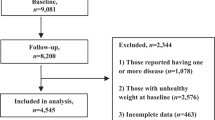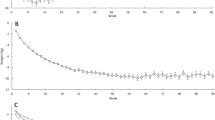Abstract
Background/objectives:
Dietary pattern studies are traditionally the domain of epidemiological research. From a clinical perspective, there is a need to explore the effects of changing food and dietary patterns of individuals. The aim was to identify patterns of food choice in the context of a clinical weight loss trial. Cluster analysis based on reported serves of food groups revealed dietary patterns informative for the clinical setting.
Subjects/Methods:
Cluster analysis was conducted using diet history data from two clinical trials at baseline, and outcomes at 3 months were reviewed based on these clusters (n=231). The cluster solution was analysed using defined food groups in serves and with respect to clinical parameters and requirements for selected nutrients.
Results:
Two distinct dietary patterns were identified from the reported baseline dietary intakes. Subjects in Cluster 1 reported food patterns characterised by higher intakes of low-fat dairy and unsaturated oils and margarine and were generally more closely aligned to food choices encouraged in national dietary guidelines. Subjects in Cluster 2 reported a dietary pattern characterised by non-core foods and drinks, higher- and medium-fat dairy foods, fatty meats and alcohol. At 3 months, Cluster 2 subjects reported greater reductions in energy intake (−5317 kJ; P<0.001) and greater weight loss (−5.6 kg; P<0.05) compared with Cluster 1.
Conclusions:
Overweight subjects with reported dietary patterns similar to dietary guidelines at baseline may have more difficulty in reducing energy intake than those with poor dietary patterns. Correcting exposure to non-core foods and drinks was key to successful weight loss.
This is a preview of subscription content, access via your institution
Access options
Subscribe to this journal
Receive 12 print issues and online access
$259.00 per year
only $21.58 per issue
Buy this article
- Purchase on Springer Link
- Instant access to full article PDF
Prices may be subject to local taxes which are calculated during checkout
Similar content being viewed by others
References
Hu FB . Dietary pattern analysis: a new direction in nutritional epidemiology. Curr Opin Lipidol 2002; 13: 3–9.
van Dam RM, Rimm EB, Willett WC, Stampfer MJ, Hu FB . Dietary patterns and the risk for type 2 diabetes in U.S. men. Ann Intern Med 2002; 136: 201–209.
Fung TT, Willett WC, Stampfer MJ, Manson JE, Hu FB . Dietary patterns and the risk of coronary heart disease in women. Arch Intern Med 2001; 161: 1857–1862.
Fung TT, Rimm EB, Spiegelman D, Rifai N, Tofler GH, Willett WC et al. Association between dietary patterns and plasma biomarkers of obesity and cardiovascular disease risk. Am J Clin Nutr 2001; 73: 61–67.
Martınez-Gonzalez MA, Sanchez-Villegas A . The emerging role of Mediterranean diets in cardiovascular epidemiology: Monounsaturated fats, olive oil, red wine or the whole pattern? Eur J Epidemiol 2004; 19: 9–13.
Martınez-Ortiz JA, Fung TT, Baylin A, Hu FB, Campos H . Dietary patterns and risk of nonfatal acute myocardial infarction in Costa Rican adults. Eur J Clin Nutr 2006; 60: 770–777.
Hu FB, Rimm EB, Stampfer MJ, Ascherio A, Spiegelman D, Willett WC . Prospective study of major dietary patterns and risk of coronary heart disease in men. Am J Clin Nutr 2000; 72: 912–921.
Reedy J, Haines PS, Campbell MK . The influence of health behavior clusters on dietary change. Prev Med 2005; 41: 268–275.
Madlensky L, Natarajan L, Flatt SW, Faerber S, Newman VA, Pierce JP . Timing of dietary change in response to a telephone counseling intervention: evidence from the WHEL study. Health Psychol 2008; 27: 539–547.
Togo P, Osler M, Sorensen TI, Heitmann BL . Food intake patterns and body mass index in observational studies. Int J Obes Relat Metab Disord 2001; 25: 1741–1751.
Block G, Woods M, Potosky A, Clifford C . Validation of a self-administered Diet History Questionnaire using multiple diet records. J Clin Epidemiol 1990; 43: 1327–1335.
Jain M, Howe GR, Rohan T . Dietary assessment in epidemiology: comparison of a Food Frequency and a Diet History Questionnaire with a 7-Day Food Record. Am J Epidemiol 1996; 143: 953–960.
Willett W, Sampson L, Stampfer MJ, Rosner B, Bain C, WitschiI J et al. Reproducibility and validity of a semiquantitative food frequency questionnaire. Am J Epidemiol 1985; 122: 51–65.
Block G, Hartman AM, Dresser CM, Carroll MD, Gannon J, Gardner LA . Data-based approach to diet questionnaire design and testing. Am J Epidemiol 1986; 124: 453–469.
Sasaki S, Yanagibori R, Amano K . Self-administered diet history questionnaire developed for health education: a relative validation of the test-version by comparison with 3-day diet record in women. J Epidemiol 1998; 8: 203–215.
Tapsell L, Pettengell K, Denmeade SL . Assessment of a narrative approach to the diet history. Public Health Nutr 1999; 2: 61–67.
Ross LJ, Tapsell LC, Probst YC . Optimising dietary fat in a weight-loss trial requires advice based on a structured ‘whole-of-diet’ model. Nutr Res 2011; 31: 683–690.
Bailey RL, Gutschall MD, Mitchell DC, Miller CK, Lawrence FR, Smicikls-Wright H . Comparative strategies for using cluster analysis to assess dietary patterns. J Am Diet Assoc 2006; 106: 1194–1200.
Anderson AL, Harris TB, Tylavsky FA, Perry SE, Houston DK, Hue TF et al. Dietary patterns and survival of older adults. J Am Diet Assoc 2011; 111: 84–91.
Jacobs DR, Steffen LM . Nutrients, food and dietary patterns as exposures in research: a framework for food synergy. Am J Clin Nutr 2003; 78: 508S–513S.
Reedy J, Wirfalt E, Flood A, Mitrou PN, Krebs-Smith SM, Kipnis V et al. Comparing 3 dietary pattern methods—cluster analysis, factor analysis, and index analysis—with colorectal cancer risk. The NIH–AARP Diet and Health Study. Am J Epidemiol 2009; 171: 479–487.
Hu FB, Rimm F, Smith-Warner SA, Feskanich D, Stampfer MJ, Ascherio A et al. Reproducibility and validity of dietary patterns assessed with a food-frequency questionnaire. Am J Clin Nutr 1999; 69: 243–249.
Smithers LG, Golley RK, Brazionis L, Lynch JW . Characterizing whole diets of young children from developed countries and the association between diet and health: a systematic review. Nutr Rev 2011; 69: 449–467.
Grafenauer SJ, Tapsell LC, Beck EJ . Beyond nutrients: classification of foods to identify dietary patterns for weight management. In: Nutrition and Dietetics (ed)., International Congress of Dietetics: Sydney, 2012, p 78.
Scarborough P, Rayner M, Stockley L . Developing nutrient profile models: a systematic approach. Public Health Nutr 2007; 10: 330–336.
Curtin University of Tecnology. Dietitians' Pocket Book. Department of Nutrition and Dietetics and Food Science, School of Public Health, Curtin University of Technology: Perth, Western Australia, 2002.
Stewart R (ed.) Griffith Handbook of Clinical Nutrition and Dietetics. Griffith University, School of Public Health: South Port, Queensland, Australia, 2009.
Australian Government, Department of Health and Aging. The Australian Guide to Healthy Eating, 1998.
Australian Government. Nutrient Reference Values for Australia and New Zealand. Department of Health and Ageing, Ministry of Health, 2006.
Australian Government. The Australian Guide to Healthy Eating (Draft). In: National Health and Medical Research Council, Department of Health and Aging, (eds). Draft edn, 2011.
Johnson F, Pratt M, Wardle J . Dietary restraint and self-regulation in eating behavior. Int J Obes 2012; 36: 665–674.
Riet Jvt, Sijtsema SJ, Dagevos H, De Bruijn G-J . The importance of habits in eating behaviour. An overview and recommendations for future research. Appetite 2011; 57: 585–596.
Wirfalt AKE, Jeffery RW . Using cluster analysis to examine dietary patterns: nutrient intakes, gender, and weight status differ across food pattern clusters. J Am Diet Assoc 1997; 97: 272–279.
Huijbregts PPCW FeskensEJM, Kromhout D . Dietary patterns and cardiovascular risk factors in elderly men: the Zutphen Elderly Study. Int J Epidemiol 1995; 24: 313–320.
Dallal GE, Rush D, Tucker KL . Dietary patterns of elderly Boston-area residents defined by cluster analysis. J Am Diet Assoc 1992; 92: 1487–1491.
Raynor HA . Can limiting dietary variety assist with reducing energy intake and weight loss? Physiol Behav 2012; 106: 356–361.
Raynor HA, Steeves EA, Hecht J, Fava JL, Wing RR . Limiting variety in non-nutrient-dense, energy-dense foods during a lifestyle intervention: a randomized controlled trial. Am J Clin Nutr 2012; 95: 1305–1314.
Mozaffarian D, Hao T, Rimm EB, Willett WC, Hu FB . Changes in diet and lifestyle and long-term weight gain in women and men. N Engl J Med 2011; 364: 2392–2404.
Rangan AM, Schindeler S, Hector DJ, Gill TP, Webb KL . Consumption of ‘extra’ foods by Australian adults: types, quantities and contribution to energy and nutrient intakes. Eur J Clin Nutr 2009; 63: 865–871.
Kuhnle GGC . Nutritional biomarkers for objective dietary assessment. J Sci Food Agric 2012; 92: 1145–1149.
Kant AK . Dietary patterns and health outcomes. J Am Diet Assoc 2004; 104: 615–635.
Wirfalt E, Mattisson I, Gullberg B, Berglund G . Food patterns defined by cluster analysis and their utility as dietary exposure variables: a report from the Malmo Diet and Cancer Study. Public Health Nutr 2000; 3: 159–173.
Newby PK, Tucker KL . Empirically derived eating patterns using factor or cluster analysis: a review. Nutr Rev 2004; 62: 177–203.
Jacques PF, Tucker KL . Editorial: are dietary patterns useful for understanding the role of diet in chronic disease? Am J Clin Nutr 2001; 73: 1–2.
Newby P, Muller D, Hallfrisch J, Qiao N, Andres R, Tucker KL . Dietary patterns and changes in body mass index and waist circumference in adults. Am J Clin Nutr 2003; 77: 1417–1425.
Iqbal R, Anand S, Ounpuu S, Islam S, Zhang X, Rangarajan S et al. Dietary patterns and the risk of acute myocardial infarction in 52 countries. Circulation 2008; 118: 1929–1937.
Baecke JA, Burema J, Frijters JE . A short questionnaire for the measurement of habitual physical activity in epidemiological studies. Am J Clin Nutr 1982; 36: 936–942.
Baghurst K, Cobiac L, Baghurst P, Magarey A . A New food guidance system for Australia - Foundation and total diets. Revised Draft Report for Public Consultation, NHMRC, 2011: http://www.nhmrc.gov.au/_files_nhmrc/file/guidelines/consult/consultations/draft_foundation_total_diets_public_consult.pdf (accessed January 2012).
Author information
Authors and Affiliations
Corresponding author
Ethics declarations
Competing interests
The authors declare no conflict of interest.
Rights and permissions
About this article
Cite this article
Grafenauer, S., Tapsell, L., Beck, E. et al. Baseline dietary patterns are a significant consideration in correcting dietary exposure for weight loss. Eur J Clin Nutr 67, 330–336 (2013). https://doi.org/10.1038/ejcn.2013.26
Received:
Revised:
Accepted:
Published:
Issue Date:
DOI: https://doi.org/10.1038/ejcn.2013.26
Keywords
This article is cited by
-
Changes in diet quality during a 12 month weight loss randomised controlled trial
BMC Nutrition (2017)
-
Identification of dietary patterns associated with blood pressure in a sample of overweight Australian adults
Journal of Human Hypertension (2016)
-
Weight loss effects from vegetable intake: a 12-month randomised controlled trial
European Journal of Clinical Nutrition (2014)
-
Dietary Patterns May Sustain Weight Loss among Adults
Current Nutrition Reports (2014)



